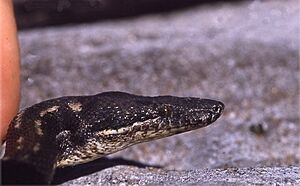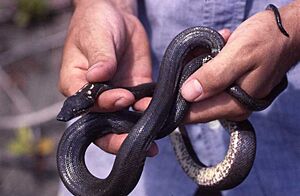Round Island boa facts for kids
The Round Island boa (Casarea dussumieri) is a special kind of snake. It's also known as the Round Island keel-scaled boa or the Round Island ground boa. This snake is not venomous, meaning it's not poisonous. It belongs to a unique group of snakes found only on Round Island in Mauritius. This island is off the coast of Africa. There are no different types (subspecies) of this boa known today.
Quick facts for kids Round Island boa |
|
|---|---|
 |
|
| Conservation status | |
| Scientific classification | |
| Genus: |
Casarea
|
| Species: |
dussumieri
|
| Synonyms | |
|
Genus:
Species:
|
|
Contents
What's in a Name?
The second part of the snake's scientific name, dussumieri, honors a French person named Jean-Jacques Dussumier. He was a merchant who loved collecting animal specimens.
About the Round Island Boa
Adult Round Island boas are thin and can grow up to 150 centimeters (about 5 feet) long. Male boas have slimmer, pointier heads and are shorter than females. Their bodies are covered in small scales that have a ridge, or "keel," down the middle. This is why they are sometimes called "keel-scaled."
This snake is very special because its jaw can split! It has a unique joint that separates the front and back parts of its jaw. This helps it catch its main food, which includes geckos and skinks (types of lizards).
The boa's color is usually dark brown on its back. Its belly is lighter with dark spots. During the day, the boa looks darker because it's less active. But in the evening and through the night, when it's most active, its skin cells change, making it appear lighter.
Where Do They Live?
The Round Island boa is currently found only on Round Island. However, in the past, there is evidence they lived on other nearby islands like Gunner's Quoin and Flat Island. They were also found on the main island of Mauritius, but only as very old remains.
The first place this snake was officially found and described was "Round Island, near Mauritius."
Good news! Between October 11 and 31, 2012, some boas were moved back to Gunner's Quoin. This was a team effort by the Durrell Wildlife Conservation Trust, the Mauritian Wildlife Foundation, and the National Parks and Conservation Service of Mauritius.
How Are They Protected?
The Round Island boa is listed as an Endangered species by the IUCN Red List. This means that even though it's not in the most critical danger, it has a very high chance of disappearing from the wild. In 1996, there were fewer than 250 adult boas left.
Thanks to a lot of hard work, the number of adult Round Island boas has grown to about 1,000! This was achieved by removing goats and rabbits from Round Island. These animals were eating the plants the boas needed. Restoring the island's natural habitat helped increase the number of lizards, which are the boas' natural food. In special breeding programs, young boas have even been fed small mice that smell like chicken to encourage them to eat.
Reproduction and Life Cycle
Round Island boas usually start breeding in April. However, baby boas can be seen throughout the year. A female boa can lay up to 12 soft-shelled eggs. She often hides them in leaf piles or inside hollow palm tree trunks. Sometimes, the mother snake stays near her eggs.
It takes a long time for the eggs to hatch, about 90 days, which is unusual for a snake. When they are born, the baby boas are bright orange and weigh less than 5 grams.



